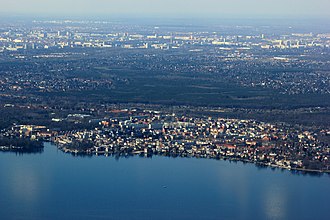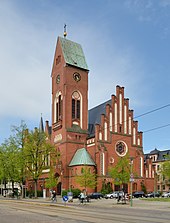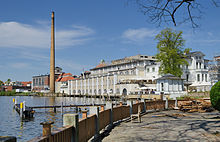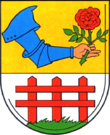Berlin-Friedrichshagen
|
Friedrichshagen district of Berlin |
|
|---|---|
| Coordinates | 52 ° 27 ′ 0 ″ N , 13 ° 37 ′ 0 ″ E |
| height | ≈ 34 m above sea level NN |
| surface | 14.02 km² |
| Residents | 19,145 (Dec. 31, 2019) |
| Population density | 1366 inhabitants / km² |
| Incorporation | Oct. 1, 1920 |
| Post Code | 12587 |
| District number | 0911 |
| structure | |
| Administrative district | Treptow-Koepenick |
| Locations | |

Friedrichshagen is a district in the Berlin district of Treptow-Köpenick , on the north bank of the Müggelsee .
Location description
The center of Friedrichshagen is Bölschestrasse , which represents two centuries of building history. The street, known for its shopping opportunities and diverse gastronomy, has been able to maintain its character - on the one hand a lifeline and on the other hand a promenade - through renovation measures.
The premises of the Berliner Bürgerbräu brewery were located at the confluence of Bölschestrasse and Müggelseedamm - very close to the Spree tunnel . Until it closed in 2010, it was the last private and oldest brewery in Berlin. Parts of the industrial building of the private brewery have been placed under monument protection.
In the direction of Rahnsdorf, there is the Friedrichshagen waterworks on both sides of the Müggelseedamm . The old waterworks Friedrichshagen is the terminus of the tram line 60 from Johannisthal .
The tram line 88 is a regional tram that runs from the S-Bahn station Friedrichshagen via Schöneiche to Alt-Rüdersdorf .
history
Friedrichshagen was founded as a colonist village Friedrichshagen on May 29, 1753 on behalf of Friedrich II . Mainly cotton spinners from Bohemia and Silesia were settled there, who lived in simple clay half-timbered houses. They operated cotton spinning at home and earned their living in the winter months by making brooms . In order to earn additional income by selling sweet mulberries , the people of Friedrichshagen planted several hundred mulberry trees. A long suspected silkworm breeding did not exist, however.
In the middle of the settlement, the residents of the village built a prayer room with a school room and a teacher's apartment. It was not until 1800 that they got their own house of worship, but it was just a simple hall structure , to which a bell tower was added in 1848.
In 1842 the Friedrichshagen stop was opened on the route of the Lower Silesian-Märkische Railway from Berlin to Frankfurt (Oder) . Thanks to this favorable transport connection, Friedrichshagen developed into a villa suburb and a popular excursion destination for “ summer visitors ” who particularly enjoyed the scenic charms of the Müggelsee in the 19th century . Friedrichshagen received the title of “Climatic Health Resort” around 1880, and two bathing areas were created on Müggelsee, the spa park, as well as beer gardens , cafes and hotels.


In 1887 Hermann Gladenbeck relocated his famous fine art foundry to Friedrichshagen. Until 1926, statues and monuments were cast in bronze according to the designs of well-known sculptors .
From 1889 a large waterworks in the style of a neo-Gothic monastery was built in Friedrichshagen to supply water to the east of Berlin and opened on October 28, 1893. After numerous extensions and modernizations, the Friedrichshagen waterworks is still in operation today. The waterworks museum of the Berliner Wasserbetriebe has been located in a pumping machine house on the banks of the Müggelsee since 1987 . The entire company premises are under monument protection .
The Friedrichshagener Dichterkreis was founded in 1890 . Writers, artists and scientists chose the location Hinter der Weltstadt (book title by Wilhelm Bölsche ) because on the one hand they valued peace and nature for their creative phases, but on the other hand they valued the closeness to the publishers (see also: New Friedrichshagener Dichterkreis ) .
The simple hall church (probably a plastered brick building in baroque - classicist forms around 1800 ) on the market square (1903–1920 Friedrichsplatz ) was replaced by the much larger Christophorus Church in 1903 , because the population had increased significantly. On September 25, 1904, a monument to Frederick II was ceremoniously unveiled opposite her. Its costs considerably exceeded the annual social budget of the then still small town. The memorial survived both world wars without damage, but was knocked off its base after the end of the Second World War . It was only melted down in 1946 after collecting non-ferrous metals .
The town in the Köpenick district, which at that time had 14,850 inhabitants, was incorporated into Greater Berlin in 1920.
In order to increase the stimulation of excursion traffic on both sides of the Müggelspree , the overloaded ferry service was replaced by the Spreetunnel Friedrichshagen in 1927 . It consists of two tunnels cast in concrete on an island in the middle of the Spree, which were then sunk and joined together under water; at that time a pioneering achievement of technical architecture. You can change to the south side of the Müggelsee through the Spree tunnel and get to the excursion restaurants on dry feet.
In November 1972, the tower of St. Christopher's Church was so badly damaged during the Quimburga hurricane that it had to be removed. Due to a lack of financial and material resources, the church tower could only be rebuilt years later in a shortened and simplified form.

With the 250th anniversary of Friedrichshagen in 2003, a new bronze statue of Frederick II, created by the Armenian sculptor Spartak Babajan , was erected on the square (market square) opposite the Christophorus Church, based on the monument erected in 1904. A citizens' initiative had collected donations for this. The sculpture was cast in the Seiler fine art foundry in nearby Schöneiche . The new statue depicts the king who , at the age of 41, conquered "a new province in peace" through the reclamation of tracts of land, the establishment of new villages and the settlement of colonists . Frederick II wears his typical uniform and supports himself the right hand on the cane, which is slightly extended to the side.
Hirschgarten location
In Friedrichshagen, on the suburb of Köpenick, there is the Hirschgarten location with the S-Bahn station of the same name. Hirschgarten was founded as a villa colony in June 1870 by the banker Albert Hirte according to a development plan by Eduard Titz . The name of the place is said to be derived from the name of the banker Hirsch, who was one of the first to build a villa here. At that time, a natural swimming pool was built in Hirschgarten, which was particularly attractive because it had a warm spring. When the spring dried up, the brine baths were stopped. In Hirschgarten, the Neuenhagener Mühlenfließ (also called "Erpe") flows into the Spree .
population
|
|
Source: Statistical Report AI 5. Population in the State of Berlin on December 31st. Basic data. Office for Statistics Berlin-Brandenburg (corresponding years)
Culture
Because of its location in the extreme southeast of Berlin, Friedrichshagen has remained a so-called “artist village” to this day. Every summer visual artists open their studios and provide insights into their work. In addition, Friedrichshagen is home to a large number of galleries in which works by artists from all over Europe can be seen in changing exhibitions.
The Naturtheater Friedrichshagen, built in 1930, in the immediate vicinity of the S-Bahn station, offers cinema screenings and concerts in the open air in summer and complements the offerings of the historic Union cinema on Bölschestrasse. In addition to regular concerts and cabaret events, the “pub festival” that takes place in spring and autumn is one of the musical highlights. For one night, music lovers can choose from a variety of bars, from classical to jazz to rock and blues . Every year in autumn, the “Dichter.dran” cultural festival is held in Friedrichshagen. For an entire weekend, cultural events are offered in many shops, studios, schools and other venues. The “Bölschefest” is held on the Bölschestrasse on the second weekend in May every year. This spectacle regularly attracts around 200,000 visitors to the district, who stroll through the street, watch the cultural program on the stage on the market square and enjoy the fireworks over the nightly Müggelsee.
The film Hai-Alarm am Müggelsee is set in Friedrichshagen and was also shot there.
Sports
With the Orange-Weiß Friedrichshagen tennis club founded in 1908, the largest tennis club in East Berlin is located in Friedrichshagen. Football has been part of today's Friedrichshagener SV club since 1912 (numerous name changes).
schools
Friedrichshagen has a total of six schools. There are two secondary schools, the Gerhart-Hauptmann-Gymnasium (GHS) and the Wilhelm-Bölsche-Schule. There are also three primary schools.
traffic
Streets
The central street of the district is Bölschestrasse , which crosses it in a north-south direction. It begins at Fürstenwalder Damm in the north and ends at Müggelseedamm in the south, both of which touch the district in a west-east direction. There are other road connections in the direction of Dahlwitz-Hoppegarten via Dahlwitzer Landstrasse and to Schöneiche via Schöneicher Strasse .
Friedrichshagen S-Bahn station
Friedrichshagen has been connected to the railway network via a train station on the Lower Silesian-Märkische Bahn since 1842 . The Berlin S-Bahn ( line S 3 Spandau - Erkner ) has stopped here since 1928 .
The S-Bahn station is also a transfer point to the Berlin tram (lines 60 and 61) and the Schöneich tram (line 88), which opened in 1910 . The Friedrichshagen tram had been in operation in the village since 1891, and was taken over by the Cöpenicker tram in 1906 , which in turn merged with the Berlin tram in 1920.
Hirschgarten S-Bahn station
On May 1, 1894, a stop with two side platforms was built in Hirschgarten . In 1902 two more tracks were added. A new central platform was built, which was accessible via a tunnel. Cast iron columns with a gable roof served as the platform roof. On June 11, 1928, the S-Bahn began operating. There was never a reception building . In April 1945 operations were stopped for the time being. But on April 30, 1948, single-track operation was resumed. On July 31, 1956, the station received a second track.
See also
- List of cultural monuments in Berlin-Friedrichshagen
- List of streets and squares in Berlin-Friedrichshagen
- List of stumbling blocks in Berlin-Friedrichshagen
literature
- Albert Burkhardt: A tour through Friedrichshagen on the trail of the circle of poets. Friedrichshagen booklets. Volume 14. 3rd edition Brandel, Berlin 2001.
- Rolf F. Lang (Ed.): Festschrift 250 Years Friedrichshagen (1753–2003). Ed. I. A. of the Kulturhistorisches Verein Friedrichshagen e. V. Edition Friedrichshagen. Volume 7. Müggel-Verlag, Berlin 2003, ISBN 3-9806805-7-6 .
- Marcel Piethe: A crazy village. What Friedrichshagen came from. In: The Mark Brandenburg. Issue 75, Berlin 2009, ISBN 978-3-910134-11-9 .
- Katrin Brandel: Friedrichshagen - old postcards from the edge of Berlin. 1st edition. Brandel, Berlin 2009. ISBN 978-3-00-029385-6 .
- Katrin Brandel, Aribert Giesche: Local appointment in Friedrichshagen. From inns and pubs on the outskirts of Berlin. 1st edition Brandel, Berlin 2011, ISBN 978-3-00-036551-5 .
- Katrin Brandel (Ed.): Friedrichshagener Hefte No. 1–66. Berlin 1995-2014.
- Distant places. Photographs from the southeast of Berlin. Köpenick and Friedrichshagen in the 70s and 80s. With black-and-white photographs by Martin Claus, Frank Odening and Peter Tschauner, Berlin 2014. ISBN 978-3-00-048065-2 .
Web links
- Pages of the district office: Friedrichshagen, conservation statute
- Photo album Friedrichshagen
- Facades of houses in Friedrichshagen
Notes and individual references
- ^ LHA Potsdam, Rep. 2, 1st cathedral. Reg. D 10661
- ↑ A similar founding of colonists for religious refugees was the Müggelheim built in 1747 in the immediate vicinity.
- ↑ Aribert Giesche and Karl-Ludwig Lange, Lukas Verlag, Berlin 2018, ISBN 978-3-86732-270-6
- ↑ Through Hirschgarten and the Westend of the East. In: Berliner Morgenpost , June 3, 2012.
- ↑ Statistical report AI 5 - hj 2 / 19. Residents in the state of Berlin on December 31, 2019. Basic data. P. 26
- ↑ Rene Meintz: Gerhart-Hauptmann-Gymnasium. April 2, 2013, accessed December 15, 2019 .
- ^ Rene Meintz: Wilhelm Bölsche School. March 23, 2012, accessed December 15, 2019 .
- ↑ a b Jürgen Meyer-Kronthaler, Wolfgang Kramer: Berlin's S-Bahnhöfe - A three-quarters of a century . Be.bra, Berlin 1998 ISBN 3-930863-25-1 .





